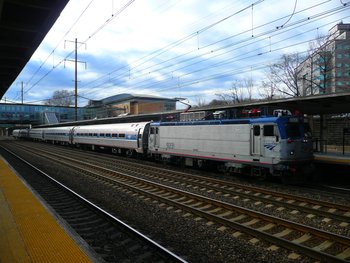Amtrak AEM 7 Electric Loco

The AEM-7 is a twin-cab B-B electric locomotive that is used in the United States on the Northeast Corridor between Washington DC and Boston and the Keystone Corridor between Philadelphia and Harrisburg in Pennsylvania. They were built by Electro-Motive Division from 1978 to 1988.
http://en.wikipedia.org/wiki/AEM7
Sound Projects
Project electra E .spj RE WORK by Miniatureengineer:EMD/ASEA AEM-7 sound scheme. Copright (c) Alex Stroshane 3 August 2008
all attributes to the original Authors for the ability to be able to use this sound project
project: AEM7.spj
SDF: EMD/ASEA AEM-7 Electric Scheme
Author: Alex Stroshane
Most of the spj's in this rework have been changed in some way or form and new ones added to make this project what it is
(A) Function Key Usage:
F0- Lights
F1- Bell
F2- Horn [CV150 selects Horn type]
F3- Coupler crash [Autocoupler/brake set by CV151 max spd]
F4- Air features disable - F4 to OFF enables pop-off,drier and starts compressor
F5- Dynamic brakes
F6- Not assigned
F7- Not assigned
F8- Mute control, [F8 ON is muted.]
F9- Engine brake squeal
F10- Grade crossing airhorn sequence
F11- Milepost indicator
(B) AEM-7 Sound FX defined CV's: [sound project download reset value in sq. brackets]
CV58 Master Volume, 0-15, 0= max, (F8 used for mute) [9]
CV122 Product type, 12 = Digitrax SFX sound decoder (Read Only Value)
CV123 Hardware version (Read Only Value)
CV135 Volume when muted [00]
User configurable Sound CV's:
CV140 Prime mover volume 0-64 [60]
CV141 Bell volume 0-64 [20]
CV142 Horn volume 0-64 [60]
CV143 Air features volume (popoff, drier, comp) 0-64 [30]
CV144 Dynamic brake volume 0-64 [30]
CV145 Misc volumes 0-64 [40]
CV146 Bell delay (1 = 24mS) 1-100 [0]
CV147 Drier rate (1 = about 2 secs) 1-64 [05]
CV148 Compressor start rate [30]
CV149 Compressor run time [20]
CV150 Horn select: 0=default, 1=playable default, 2=alt. horn, 3=playable alt. [0]
CV151 Peak speed to allow auto coupler/brake on DIR change and F3 on 0-60 [48]
CV152 Author ID Alex Stroshane = 0xAA [170]
CV153 Project ID AEM-7 [09]
CV154 Auto horn signals: 0 = Off, 1= On 0-1 [00]
CV156 Bell selector: 0=default, 1=alternate 0-1 [00]
(C) General Notes
This sound project was designed for the AEM-7 locomotives built for Amtrak and several commuter railroads by EMD, ASEA and
Budd. The same sounds would also be suitable for the ALP-44 locomotives owned by New Jersey Transit.
Because the throttle of an electric locomotive is continuous, with no "notch" positions, there is no semi-auto or manual
notching functionality in this project. Instead, the sound of the traction motors varies directly with the speed. In real
life, little is heard above the humming sound of the blowers that run constantly - electrics are a lot quieter than diesels!
This sound project has been assembled from Digitrax-supplied sound clips as well as new sounds from custom recordings. I am
also indebted to Bob Grosh and Fred Miller for their early work in deciphering the SDF language and engineering new functions.
Some engine sound recordings by Alex Stroshane, copyright 2006, recorded in Boston, MA and Wilmington, DE.
Additional engine and horn/bell sound clips courtesy of Matt Donnelly, recorded from various prototypes around the Northeast.
------[end AEM7 SDF/DECODER definition]--------------
SoundLoader Software
Using your PR3 programmer and SoundLoader Software, it’s quick and easy to download sound project files into your Digitrax FX decoders.
Format Information
With Digitrax Sound FX decoders and downloadable sound project files (.spj), you can download your choice of sound schemes into any Sound FX equipped locomotive. You can use spj’s that are available for free, you can modify those schemes or you can create your own!
Sound Decoders
Digitrax offers a wide variety of Sound FX decoders to fit many different locomotives. You’ll need to have a Digitrax SFX decoder installed to take advantage of using .spj files.
Click here for Digitrax Sound FX decodersSubmit your Sound Projects
Use our submission form to submit your Sound Projects

Click here to submit your sound project